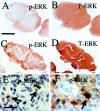Phosphorylation state-specific antibodies: applications in investigative and diagnostic pathology
- PMID: 14578166
- PMCID: PMC1892416
- DOI: 10.1016/S0002-9440(10)63525-0
Phosphorylation state-specific antibodies: applications in investigative and diagnostic pathology
Abstract
Until recently, the investigation of protein phosphorylation was limited to biochemical studies of enzyme activities in homogenized tissues. The availability of hundreds of phosphorylation state-specific antibodies (PSSAs) now makes possible the study of protein phosphorylation in situ, and is opening many exciting opportunities in investigative and diagnostic pathology. This review illustrates the power of PSSAs, especially in immunohistochemical applications to human disease and animal models. Technical considerations, including antibody specificity and lability of phosphoepitopes, are covered, along with potential pitfalls, illustrated by a case study. In the arena of oncology, PSSAs may prove especially valuable in directly demonstrating the efficacy of chemotherapies targeted at protein kinase cascades. Novel applications of PSSAs are also beginning to reveal molecular mechanisms of inflammatory, degenerative, and toxin-induced diseases.
Figures

References
Publication types
MeSH terms
Substances
Grants and funding
LinkOut - more resources
Full Text Sources
Other Literature Sources

